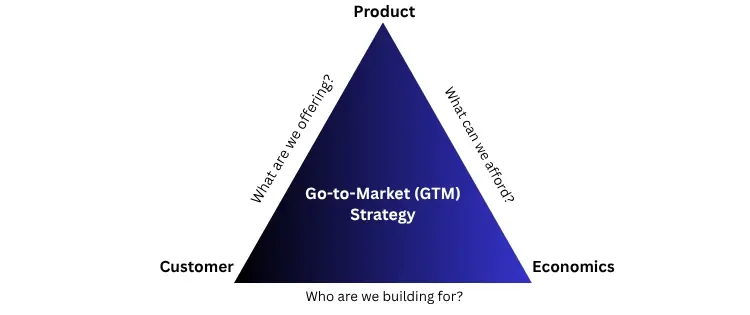
Our Blog
We help junior tech professionals, such as developers and designers, to grow.
Getting your product to the right people
Mariana Caldas 2025-08-03

And here we are in the final article of the product management lifecycle series, inspired by the Stanford course, "Product Management: Transforming Opportunities into Great Products." In this series, we’ve been walking through the product lifecycle, not just from a theoretical standpoint, but through the lens of what it takes to bring ideas to life in a way that makes sense for users, teams, and businesses.
A recap of what we’ve covered so far:
We now arrive at the final core phase in the product lifecycle: Go-to-Market (GTM).
If launching is the first conversation with our users, then GTM is what keeps that conversation going and helps the right people hear it.
What is Go-to-Market?
Go-to-Market is not just a distribution plan; it’s a cross-functional strategy that defines how your product reaches and retains the right users. It includes product design, positioning, pricing, messaging, customer support—and yes, distribution too.
In the course, GTM was defined as the process of reaching customers in a way that makes acquiring and serving them both viable and effective. That means understanding not only how people will find your product but also whether your business can sustainably support and grow with them.
Here’s a quick comparison to ground it:
Take a mental health app built for working parents. If research shows they trust parenting influencers more than app store ads, your GTM might involve co-creating content with those influencers, streamlining onboarding for busy schedules, and offering family-centric pricing. And if those same parents tend to hear about tools through pediatricians or community groups, your GTM may need to start by establishing partnerships or referral networks with those sources.
Three components of every GTM plan
The Stanford framework breaks GTM into three interconnected pillars:
Your product — What are you offering, and what makes it uniquely valuable?
Your customer — Who are you targeting, and how do they buy, learn, and use products?
Your economics — What are your margins, and what can you afford to spend on reaching and retaining users?
Let’s bring this to life with a few scenarios:
If you're building payroll software for small teams, your product might be self-serve, your customer is likely a non-technical HR manager, and your margins can’t support a full sales team. Your GTM may rely on SEO landing pages, free trials, and short demo videos.
If your product has a high customer lifetime value (LTV)—such as Workday, with its enterprise contracts—you can afford a long sales cycle and a human-led sales team.
If you’re Dropbox, trying to convert individuals with low LTV into paying users, you’ll likely depend on low-cost strategies like referrals or freemium upgrades.
Each decision, from pricing to onboarding, flows from this Product-Customer-Economics triangle. It helps you understand what tactics are viable, and what’s likely to stretch your resources thin.
Aligning GTM with product economics
Let’s delve deeper into the economic point to understand its metrics and establish your plan while protecting your profit margins.
LTV (Customer Lifetime Value): the total revenue a customer brings over time.
CAC (Customer Acquisition Cost): how much you spend to acquire each customer.
Your GTM strategy is only viable when CAC is significantly lower than LTV. A healthy ratio is often 1:3 or better.
For example, if your LTV is $300, you can’t afford a $250 CAC—you’ll burn money with every user. However, if your LTV is $30,000, a higher CAC is acceptable, and GTM efforts, such as demos, onboarding support, or even direct sales, are sustainable.
Matching channels to customer types
The course breaks down GTM motions by customer type:
B2C (Consumer): Prioritizes reach and simplicity. Think referral programs, viral content, and intuitive onboarding.
SMB (Small Business): Blends self-serve flows with just enough support. Think product-led growth, webinars, and email nurtures.
Enterprise: Involves high-touch sales, security reviews, and internal enablement. The GTM focus here is helping internal champions make the case.
The lesson here is alignment. If you're designing for enterprises but expecting B2C-style organic growth, you're likely to hit friction in adoption, retention, or scalability.
When the product becomes the channel
Sometimes, your best GTM tool is the product itself. Hotmail did it with one line at the end of every email: “Get your free Hotmail account.” Dropbox gave users free storage for inviting friends. PayPal paid users to sign up and send money.
More than “Marketing hacks”, those companies leveraged design choices that enabled distribution from the inside out.
Whether through shareable moments, in-app prompts, or embedded use cases, this kind of growth tends to be the most scalable and often the most delightful.
💡 Tip: Ask yourself: “How could this product help users discover or share it without needing a campaign?”
Final thoughts
This course takeaway has stayed with me:
Distribution is not a post-launch activity. It’s a product design choice.
When we align pricing, positioning, and onboarding with how people first hear about us—or how they expect to experience value—we’re building GTM into the product, not bolting it on later.
It’s easy to label this as something “Marketing handles”, but when GTM fails, it’s often because early product decisions weren’t aligned with the business model or customer journey.
I also want to note that Go-to-Market isn’t the end of the product lifecycle; it’s what connects everything that came before to everything that comes next while making growth sustainable, learnings repeatable, and outcomes visible. It’s where product and business intersect and where your team’s intentions (to help, to solve, to delight) meet the reality of reaching people and growing responsibly. So, GTM turns strategy into traction.
As this series comes to a close, I hope the core message has been clear:
Product Management requires understanding how each phase informs the next and how each decision builds momentum for the ones that follow.
Thank you for reading, learning, and hopefully building alongside me.
Talk soon, take care.
Related Posts

